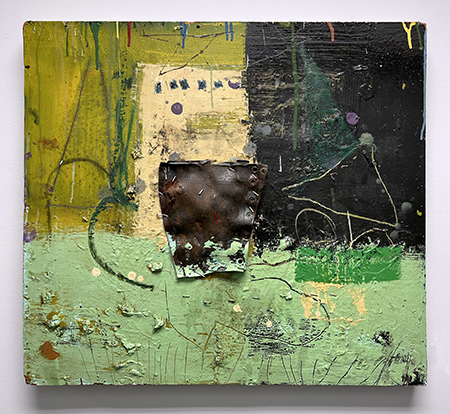Picture of the Week: Eyes Opened by Tyree Guyton
February 11, 2023

Tyree Guyton is a Detroit-based Neo-Expressionist artist, who also champions Graffiti Art and Urban Environmental art. He is most commonly known for the Heidelberg Project: the transformation of his childhood home into an indoor and outdoor art museum, which he started in 1986. He was first introduced to art as a child by his grandfather. However, he spent his early years serving in the US Army. Following his time in the army, Guyton worked in the automobile industry for Ford Motor Company and eventually Chrysler, where he was a member of the UAW. He went on to become a firefighter, but he realized that art was his true passion. Guyton strives to create artwork that promotes social change by addressing issues such as “racism, economic imbalances, politics, and the systematic inability of the government and other support agencies to help Detroit’s poorest citizens.”
Guyton studied at the College for Creative Studies in Detroit for two years but dropped out after being told he did not fit in. Nevertheless, the school awarded him with an Honorary Doctorate of Fine Art in 2009. Additionally, Guyton was the first artist to receive the Ecumenical Theological Seminary award with an Honorary Doctorate of Humane Letters in 2016. His art is featured on a domestic and international scale, including in the Detroit Institute of Arts, the University of Michigan Museum of Art, the Perez Museum, and the Studio Museum of Harlem, among many others. Guyton is also the recipient of over 18 awards and fellowships, including an esteemed one-year residency at the Lorenz Haus in Basel, Switzerland. Moreover, he has been featured in scholarly journals and books in the United States and Europe. In 2007, Guyton was featured in a book published by the WSU Press entitled Connecting the Dots, Tyree Guyton’s Heidelberg Project, which became a 2008 Michigan Notable Book. Guyton has also been featured on television, most notably the Oprah Winfrey Show, and was the subject of the Emmy Award Winning Documentary, Come Unto Me, The Faces of Tyree Guyton.
Guyton’s 1989 work Eyes Opened employs enamel paint, leather, and staples on masonite. His influences of Neo-Expressionism, Graffiti art, and Urban Environmental art appear to intersect in this work. The varying thickness and shapes of the brushstrokes, paired with Guyton’s use of leather, create a richly textured composition characteristic of Neo-Expressionism, as well as the expressive forms present in Graffiti art. Guyton’s use of masonite is reminiscent of the construction of items like furniture, which speaks to the influence of Urban Environmental art in his work. Additionally, perhaps Guyton’s use of leather and staples draws from Detroit’s Cass Corridor art movement as well, which privileges an industrial aesthetic. Guyton created this work at the end of a tumultuous decade for the city of Detroit. Throughout the 1980s, white residents abandoned the city, and the auto industry had fallen, leaving the city with “a diminished tax base and a set of horrific social problems.” Moreover, Detroit had a very high unemployment rate. Given this historical context, Guyton’s title Eyes Opened takes on a profound meaning. Perhaps the title functions as a way for Guyton to call the challenges of Detroit to the attention of his viewers; Eyes that were once closed, are now open to see the harsh reality of the city. The leather fragment, paired with the staples, may allude to Detroit’s struggles and efforts to stay afloat. To add, the diverse shapes throughout the composition may reference industrial innovations that never came to fruition due to the city’s economic turmoil. Acknowledging problems is the first step to arriving at solutions. Likewise, by bringing attention to the economic and social problems in Detroit, Guyton starts the process of developing solutions. Moreover, this message in turn aligns with Guyton’s desire to compose art that promotes social change.
Written by Angela Athnasios
Sources: https://www.tyreeguyton.com/about
https://www.heidelberg.org/tyree-guyton
https://www.theartstory.org/movement/street-art/
https://www.nytimes.com/1990/07/29/magazine/the-tragedy-of-detroit.html#:~:text=THE%20WHITE%20ABANDONMENT%20OF%20Detroit,infant%20mortality%20throughout%20the%201980's.